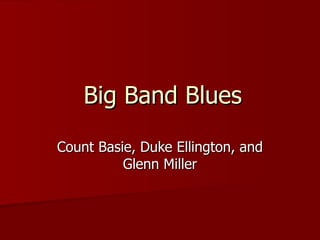
Big Band Blues Greats Basie, Ellington & Miller
- 1. Big Band Blues Count Basie, Duke Ellington, and Glenn Miller
- 2. William “Count” Basie (1904–84) Basie’s band was the most closely associated with the blues tradition. Basie was born in New Jersey. His early experience was as a piano player and bandleader in Kansas City, Missouri.
- 3. Boogie-Woogie One important influence on the rhythmic conception of the Kansas City bands was the boogie-woogie blues piano tradition. – Sprang up during the early twentieth century in the “southwest territory” states of Texas, Arkansas, Missouri, and Oklahoma and became a popular fad during the big-band era – Solo pianists developed a powerful style that could be heard over the crowd noise.
- 4. Edward Kennedy (Duke) Ellington (1899–1974) Widely regarded as one of the most important American musicians of the twentieth century Born in Washington, D.C., the son of a navy blueprint maker Came from a middle-class background and received formal musical training at a young age As a kid, he hung around the bars and pool halls where ragtime pianists played.
- 5. Edward Kennedy (Duke) Ellington (1899–1974) His first band, the Washingtonians, played syncopated dance music in New York in the early 1920s. Three years later, Ellington’s band was heard by a song publisher and promoter named Irving Mills, who arranged a recording contract for them.
- 6. Cotton Club in Harlem From 1927 to 1931, the Ellington band appeared at The Cotton Club in Harlem. The band often had to accompany “exotic” revues, and Ellington developed a style that he called “jungle music,” characterized by – dense textures, – unusual harmonies, and – muted, growling sounds in the brass. Although this style reinforced the stereotypes of black culture that many of the white patrons of the Cotton Club came to see and hear, it also provided Ellington with the basis for a unique approach to arranging for the big band.
- 7. Individualistic Approach to Writing Ellington experimented with the same basic musical resources as other big band arrangers: – Devised unusual musical forms – Combined instruments in unusual ways – Created complex, distinctive tone colors – Wrote for extreme registers of instruments – Wrote dissonant chord voicings Ellington’s experiments were aided by the remarkable stability of his band. – He grew to know the individual players’ strengths and weaknesses. – He wrote parts specifically for particular musicians.
- 8. Less Commercial Success Even though Ellington was well respected as a composer and had some big hits, he had less commercial success than other band leaders. Ellington’s idiosyncratic approach meant that his band enjoyed less commercial success than more mainstream-sounding dance orchestras.
- 9. Glenn Miller (1904–44) Trombonist/bandleader From 1939 until 1942, the Miller Orchestra was the most popular dance band in the world, breaking records for record sales and concert attendance. Most of his songs are still popular with swing dancers. Miller developed a peppy, clean-sounding style that appealed to small-town Midwestern people as well as to the big-city, East and West Coast constituency.
- 10. Glenn Miller (1904–44) Joined the Army Air Corps in 1942 Led a band in the military Was killed during World War II when his plane went down over the English Channel in 1944
- 11. Listening: “In the Mood” Performed by Glenn Miller and His Orchestra (1939) Number One on the charts for twelve weeks Best-known recording of the swing era Tune based on a short riff featured in the saxophones Twelve-bar blues with an eight-bar bridge “Trick” ending, with the band getting quieter and quieter and then exploding into a big finish Use of “call and response”
- 12. Listening: “In the Mood” Introduction (eight) A (twelve-bar blues) A (twelve) B (eight-bar phrase) B repeat B (eight) two saxes alternate solos B (eight) repeat
- 13. Listening: “In the Mood” Connecting phrase/bridge (four) B (eight) trumpet solo B (eight) repeat Connecting phrase (two) whole band A (twelve plus two) main riff returns A (twelve plus two) same music but quieter A (twelve) even softer A (twelve plus six) same music but loud
- 14. Goodman, Basie, Ellington, Miller
- 15. Mills Brothers African American vocal harmony group The most successful and longest-lived of the swing-era vocal groups Perfected a secular version of the African American jubilee quartet tradition Their smooth, jazz-influenced style appealed to a broad audience.
- 16. ASCAP, the AFM, and the Decline of the Big Bands The big radio networks were feuding with ASCAP over royalties. In 1940, the radio networks formed a rival licensing agency, Broadcast Music Incorporated (BMI). BMI allowed songwriters outside of Tin Pan Alley to collect royalties from the use of their songs in the broadcast media. – This boosted country and western and rhythm & blues musicians. In 1941, ASCAP called a strike, withdrawing the rights to broadcast any material composed by their members. In 1942, the American Federation of Musicians called a strike against the recording companies. In the end, the strike put many dance band musicians out of work.